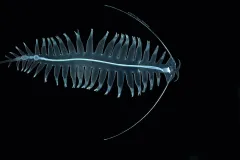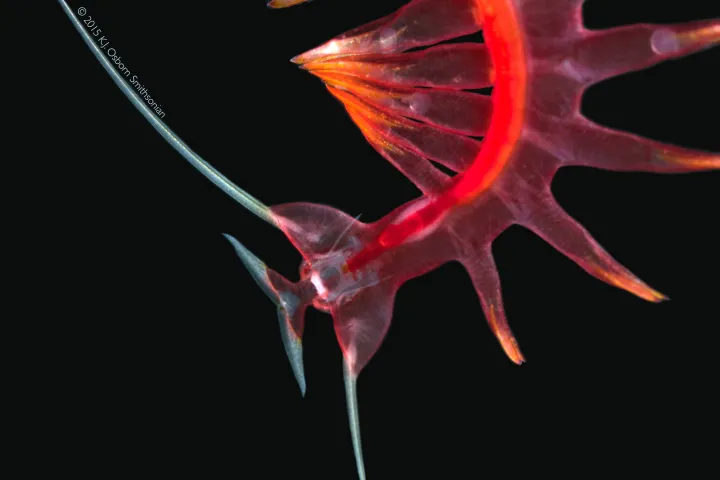Tech Imitates Life: Sneaky Sea Worm Inspires Soft Robots

Technology is evolving faster than ever, and that means sci-fi fantasies of human-like androids and adorable mechanical “pets” seem less outrageous. Already, a trend of very real bioinspired innovations fuel a new domain of tech: soft robotics. Eels, octopus, and manta rays are just a few of the marine animals that now have soft robot counterparts. Some marine scientists, though, believe a type of mysterious bristle worm called Tomopteris could be the next to enliven the field.
Learning from the Best
The term soft robotics emerged in the 2000s, but engineers have always been driven by a demand for safer, lighter, and more flexible machines. As bendy materials like silicon became more accessible and energy-producing components more compact, soft robotics labs burgeoned. The growth of this field means an expansion of technological possibilityーsoft roboticists seek to apply their work to far reaching disciplines, from surgery and entertainment to, of course, marine science.
To generate new ideas, some inventors study the oldest designs the world has to offerーthe designs of nature. Biomimicry, the practice of replicating biology in design and technology, is a central tenet of soft robotics. Animals and plants have already developed their own solutions to many of our technological obstaclesーso why not learn from them? Marine scientists especially appreciate this approach, since they abandon their natural element every time they plunge into the water. While we struggle with the sea, a whole world of animals masters it.
Tomopterid Teachings
Deep sea researchers have long looked to improve their research methods. Submersibles carry many burdensーthey are stiff, noisy, and costly. These are crucial problems when collecting fragile animals and studying delicate ecosystems, especially as they become more vulnerable due to climate change and ocean acidification. Karen Osborn, a curator at the National Museum of Natural History, says Tomopterids, an expectation-defying group of bristle worms, could hold the key to more efficient and sustainable marine research.
Most bristle worms, also known as polychaetes, have bodies segmented by walls called septa and bristles protruding from their leg-like parapodia. Tomopterids lack both of these iconic features. Tomopterids are also less muscular than other polychaetes, with most of their muscles pushed out to a thin layer just under their outer surface. Despite these oddities, they are some of the ocean’s best swimmers. They are fast, they can swim forwards and backwards, and they are stealthy, disturbing water only within one millimeter of their bodies. These features caught Osborn’s attention and spurred her to form a cross-disciplinary team with bioengineer Kakani Katija of the Monterey Bay Aquarium Research Institute to find out how tomopterids accomplish this, work that will hopefully generate tomopterid-inspired robots.
The team involves zoologists, roboticists, engineers, modelers, and mathematicians from D.C., Ohio, California, and Hawaii. They aim to combine tomopterids’ impressive movements with robotics, but first they must understand the movement. The roles of their tails and antennae have yet to be determined, their predators and prey are ill-defined, and the paddling power of their parapodia may be underestimated. Resolving these questions will improve understanding of their maneuverability and energy usage and greatly inform the field of underwater robotics.
Osborn’s team employs some novel techniques to study the strange worm. Some specimens are microCT scanned to map out their internal structure in fine detail without the need for dissection. The team analyzes these digital reconstructions with particular interest to their sparse muscular system. High-speed videography is also useful—videos taken of live tomopterids capture the nuances of their movement which the naked eye often misses. These techniques are helping uncover the locomotory mystery of tomopterids.
Reconfiguring the Face of Tech
Karen Osborn’s tomopterids team illustrates how tech is modernizing in more ways than one. Osborn is just one of many women pushing science forward. Nina Sinatra, a lead creator of the “jellystick,” acknowledges the transforming field. “Soft robotics is incredibly democratizing,” she says, “you don’t need an advanced degree in engineering to think about how you could use unusual or new materials to build a robot. We’re not bound by previous constraints of what a robot is.” Alexandra Ralevski of the Biomimicry Institute says, “the future of biomimicry is in the hands of inventors, and the future of inventing is cross-disciplinary research. The more you have biologists talking to engineers talking to designers, then the more knowledge you can add to solve a problem.” Inclusive minds like these are opening tech to new, creative innovations.



